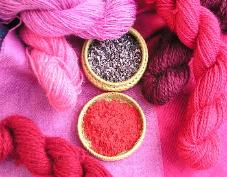 Before I picked up polymer I was a dyer. I no longer use fiber in my work but I still have a hot spot in my heart for the gorgeous colors of natural dyes. I love Kathy Hattori’s website and online store, Botanical Colors, headquartered in Seattle. Its one of the best sources for traditional dyes and pigments made from plants and animals. In today’s newsletter Hattori announced the first of “12 Days of Color” with a feature on cochineal.
Before I picked up polymer I was a dyer. I no longer use fiber in my work but I still have a hot spot in my heart for the gorgeous colors of natural dyes. I love Kathy Hattori’s website and online store, Botanical Colors, headquartered in Seattle. Its one of the best sources for traditional dyes and pigments made from plants and animals. In today’s newsletter Hattori announced the first of “12 Days of Color” with a feature on cochineal.
Once more valuable per ounce than gold, cochineal produces the brightest reds of all the natural dyes. While demand for this insect-based dye is growing, the range of the nopal cactus plants that host the cochineal bugs is dwindling. To learn everything you ever wanted to know about cochineal you can pick up the book, A Perfect Red by Amy Butler Greenfield.
Years ago I stayed with a friend in San Antonio who just happened to have cochineal bugs on the cactus plants in her yard. I scraped a few off and squished them between my thumbnails. (Humble apologies to my vegan friends.) The color was astounding! A bright magenta red!
You might remember the big hullaballoo last year about Starbuck’s use of cochineal pigment in their vegan strawberry fraps. Bugs in the base dye! They quickly replaced it with lypocene, a natural tomato-based product.
Cochineal is just one of many historically fascinating natural pigments. I’m looking forward to seeing which dye Hattori will feature tomorrow. You can follow along with the 12 Days of Color by signing up for the newsletter on Facebook.

Leave a Reply